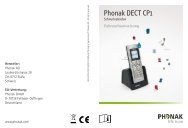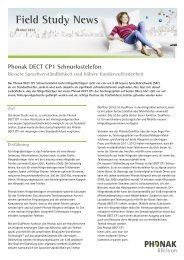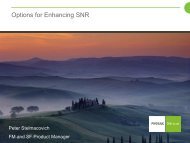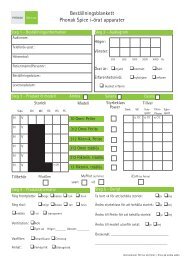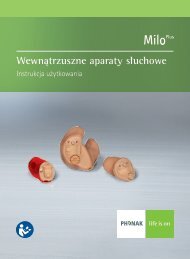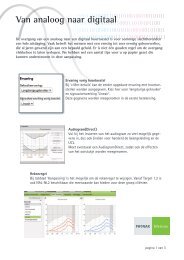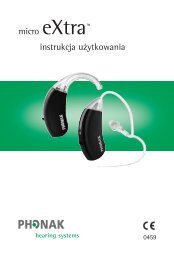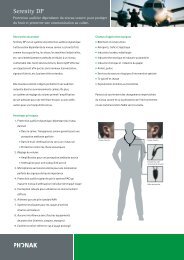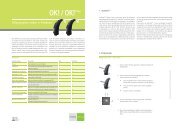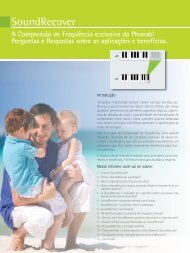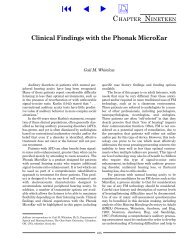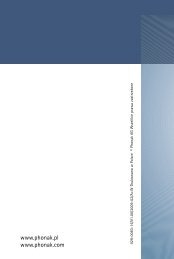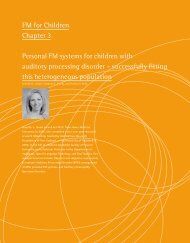Listening literacy and the neural transcription of sound - Phonak
Listening literacy and the neural transcription of sound - Phonak
Listening literacy and the neural transcription of sound - Phonak
Create successful ePaper yourself
Turn your PDF publications into a flip-book with our unique Google optimized e-Paper software.
FM for Children<br />
Chapter 1<br />
<strong>Listening</strong>, <strong>literacy</strong> <strong>and</strong> <strong>the</strong> <strong>neural</strong><br />
<strong>transcription</strong> <strong>of</strong> <strong>sound</strong><br />
Nina Kraus 1 <strong>and</strong> Karen Banai 2<br />
1<br />
Northwestern University, Evanston, IL<br />
2<br />
University <strong>of</strong> Haifa, Haifa, Israel<br />
Nina Kraus is Hugh Knowles Pr<strong>of</strong>essor, Departments<br />
<strong>of</strong> Communication Sciences, Neurobiology & Physiology,<br />
<strong>and</strong> Otolaryngology <strong>and</strong> Director <strong>of</strong> <strong>the</strong> Auditory Neuroscience<br />
Laboratory at Northwestern University.<br />
The Kraus Lab investigates <strong>the</strong> neurobiology underlying speech<br />
<strong>and</strong> music perception <strong>and</strong> learning-associated brain plasticity.<br />
The Auditory Neuroscience Laboratory studies normal listeners<br />
throughout <strong>the</strong> lifespan, clinical populations (poor-readers;<br />
autism; hearing loss), auditory experts (musicians) <strong>and</strong> an<br />
animal model. See: http://www.brainvolts.northwestern.edu<br />
Karen Banai is a lecturer at <strong>the</strong> Department <strong>of</strong> Communication<br />
Sciences <strong>and</strong> Disorders at <strong>the</strong> University <strong>of</strong> Haifa.<br />
She is investigating <strong>the</strong> development <strong>of</strong> cognitive functions<br />
associated with auditory processing <strong>and</strong> <strong>literacy</strong> <strong>and</strong> <strong>the</strong> effects<br />
<strong>of</strong> auditory training in typical <strong>and</strong> clinical populations.
10 <strong>Listening</strong>, <strong>literacy</strong> <strong>and</strong> <strong>the</strong> <strong>neural</strong> <strong>transcription</strong> <strong>of</strong> <strong>sound</strong><br />
<strong>Listening</strong>, <strong>literacy</strong> <strong>and</strong> <strong>the</strong> <strong>neural</strong><br />
<strong>transcription</strong> <strong>of</strong> <strong>sound</strong><br />
Nina Kraus 1 <strong>and</strong> Karen Banai 2<br />
1<br />
Northwestern University, Evanston, IL<br />
2<br />
University <strong>of</strong> Haifa, Haifa, Israel<br />
Impaired encoding <strong>of</strong> <strong>sound</strong> along <strong>the</strong> auditory pathway has<br />
been associated with various clinical conditions. Most relevant<br />
here are difficulties listening in noisy environments which are<br />
characteristic <strong>of</strong> <strong>the</strong> elderly, <strong>the</strong> hearing impaired <strong>and</strong> individuals<br />
with auditory processing disorder (APD), <strong>and</strong> difficulties in<br />
phonological processing characteristic <strong>of</strong> individuals with developmental<br />
language <strong>and</strong> reading disabilities. This review focuses<br />
on <strong>the</strong> latter group <strong>of</strong> children, which is estimated to comprise<br />
10-15 % <strong>of</strong> school age children (Vellutino et al., 2004). In addition<br />
to difficulties in reading, characteristic <strong>of</strong> 80 % <strong>of</strong> all children<br />
diagnosed with learning problems (Snow et al., 1998), <strong>the</strong>se<br />
children suffer from a phonological processing deficit, broadly<br />
defined as difficulties in <strong>the</strong> conscious manipulation <strong>of</strong> speech<br />
<strong>sound</strong>s. They have difficulties determining whe<strong>the</strong>r words rhyme,<br />
how words can be divided into <strong>the</strong>ir constituent<br />
syllables or phonemes <strong>and</strong> repeating<br />
non-words. While it is now agreed that<br />
poor phonological pro cessing developmentally<br />
precedes reading difficulties,<br />
<strong>the</strong> biological basis <strong>of</strong> <strong>the</strong> pho nological<br />
processing deficit itself remains poorly<br />
understood (Ramus, 2006).<br />
Current <strong>the</strong>ories <strong>of</strong> dyslexia attribute <strong>the</strong><br />
phonological deficit to inefficient use <strong>of</strong>,<br />
or access to, phonological representations when short-term<br />
memory is taxed (Ahissar et al., 2006; Ramus et al., 2008) perhaps<br />
resulting from a general deficit in dynamic tuning to <strong>the</strong> characteristics<br />
<strong>of</strong> incoming stimuli (Ahissar, 2007), ra<strong>the</strong>r than to deficient<br />
phonological representations which would result from deficient<br />
encoding <strong>of</strong> phonological features. We describe here a series <strong>of</strong><br />
investigations revealing that in a subgroup <strong>of</strong> children with poor<br />
reading <strong>and</strong> poor phonological processing, encoding <strong>of</strong> speech at<br />
sub-cortical levels <strong>of</strong> <strong>the</strong> auditory system is impaired. We propose<br />
that this impairment in encoding <strong>the</strong> acoustic- phonetic elements<br />
They have difficulties<br />
determining whe<strong>the</strong>r<br />
words rhyme, how words<br />
can be divided into<br />
<strong>the</strong>ir constituent syllables<br />
or phonemes <strong>and</strong> in<br />
repeating non-words.<br />
<strong>of</strong> speech <strong>sound</strong>s may translate to <strong>the</strong> formation <strong>of</strong> abnormal<br />
sub-lexical (input) phono logical representations <strong>and</strong> thus contribute<br />
to <strong>the</strong> development <strong>of</strong> language <strong>and</strong> reading disabilities.<br />
Also possible is that developmental language impairment<br />
impedes experience-dependent tuning <strong>of</strong> auditory function.<br />
We argue that optimal subcortical <strong>transcription</strong> is shaped by<br />
interactions between cortical <strong>and</strong> subcortical auditory mechanisms<br />
through <strong>the</strong> cortic<strong>of</strong>ugal pathway during development as<br />
reviewed in this article.<br />
Here, we focus on <strong>the</strong> encoding <strong>of</strong> speech-<strong>sound</strong>s at <strong>the</strong> upper<br />
brainstem/midbrain (<strong>the</strong> speech-ABR) in humans. We start by<br />
describing <strong>the</strong> fidelity <strong>of</strong> encoding within an individual, <strong>and</strong> how<br />
encoding is affected by expertise. We <strong>the</strong>n turn our attention<br />
to studies describing how this high fidelity<br />
is compromised in children with language<br />
based learning problems <strong>and</strong> how encoding<br />
at <strong>the</strong> level <strong>of</strong> <strong>the</strong> auditory brainstem is<br />
related to auditory processing at <strong>the</strong> cortex.<br />
Because current electrophysiological<br />
techniques pro vide reliable means to test<br />
sub-cortical, but not cortical encoding<br />
<strong>of</strong> <strong>sound</strong> at <strong>the</strong> individual listener level,<br />
we propose that <strong>the</strong>se pro perties <strong>of</strong> subcortical<br />
auditory processing carry special<br />
relevance to <strong>the</strong> study <strong>and</strong> underst<strong>and</strong>ing <strong>of</strong> APD. Namely, <strong>the</strong>se<br />
properties allow us to define an individual as having an APD if<br />
specific ele ments <strong>of</strong> <strong>the</strong>ir response are significantly disrupted.<br />
We can <strong>the</strong>n ask whe<strong>the</strong>r individuals manifesting a certain physiological<br />
pattern also share similar perceptual, <strong>literacy</strong>-related <strong>and</strong><br />
cognitive pr<strong>of</strong>iles, <strong>and</strong> whe<strong>the</strong>r current definitions <strong>of</strong> APD, language<br />
disorders or learning problems can account for <strong>the</strong> observed<br />
pr<strong>of</strong>iles, or whe<strong>the</strong>r <strong>the</strong>se physiological deficits <strong>and</strong> accompanying<br />
pr<strong>of</strong>iles “cut across” diagnoses.<br />
Address correspondence to:<br />
Nina Kraus, Department <strong>of</strong> Communication Sciences, Northwestern University, 2240 Campus Drive, Evanston IL, 60208 USA, nkraus@northwestern.edu<br />
Karen Banai , Department <strong>of</strong> Communication Disorders, University <strong>of</strong> Haifa, Mt. Carmel, Haifa, 31905 Israel, kbanai@research.haifa.ac.il
Nina Kraus <strong>and</strong> Karen Banai<br />
11<br />
Fidelity <strong>of</strong> subcortical encoding <strong>of</strong> <strong>sound</strong>:<br />
Characteristics <strong>of</strong> normal sub-cortical<br />
encoding <strong>of</strong> speech <strong>sound</strong>s<br />
Synchronized <strong>neural</strong> activity in response to <strong>sound</strong>s can be<br />
measured non-invasively in humans by means <strong>of</strong> auditory evoked<br />
potentials. Simple (brief non-speech) stimuli evoke an orderly<br />
pattern <strong>of</strong> responses from <strong>the</strong> auditory nuclei in low brainstem<br />
(waves I – III) <strong>and</strong> rostal (waves V-Vn, <strong>the</strong> FFR) brainstem nuclei,<br />
clinically known as <strong>the</strong> click-evoked ABR (Boston et al., 1985;<br />
Møller, 1999; Møller et al., 1985; Sohmer et al., 1977; Worden<br />
et al., 1968). Slight deviations from <strong>the</strong> timing <strong>of</strong> <strong>the</strong> normal<br />
pattern are associated with hearing loss <strong>and</strong> o<strong>the</strong>r pathologies<br />
(Hall, 1992; Hood, 1998). Synchronized <strong>neural</strong> activity can also<br />
be measured in response to more complex <strong>sound</strong>s like syn<strong>the</strong>tic<br />
vowels or consonant-vowel syllables. Here we review work on audi -<br />
tory evoked responses originating at rostal brainstem/midbrain<br />
nuclei that reflect <strong>the</strong> temporal <strong>and</strong> spectral characteristics <strong>of</strong><br />
complex stimuli with remarkable precision (Galbraith et al., 1995;<br />
Banai et al., 2007; Krishnan, 2002; Russo et al. 2004; Johnson<br />
et al., 2008a; Ch<strong>and</strong>rasekaran <strong>and</strong> Kraus, 2010, Hornickel et al.,<br />
2009). Please see Skoe <strong>and</strong> Kraus (2010) for a review <strong>of</strong> brainstem<br />
responses to complex <strong>sound</strong>s.<br />
brainstem origins <strong>of</strong> <strong>the</strong>se responses. Our approach to study <strong>the</strong><br />
parallels between <strong>the</strong> acoustic properties <strong>of</strong> <strong>the</strong> speech signal <strong>and</strong><br />
<strong>the</strong> brain evoked response is based upon <strong>the</strong> source/filter model<br />
<strong>of</strong> speech production (Fant, 1970; <strong>and</strong> see Kraus et al., 2005 for<br />
a detailed review <strong>of</strong> <strong>the</strong> application <strong>of</strong> <strong>the</strong> source/filter model<br />
to speech-evoked brainstem responses) <strong>and</strong> is demonstrated in<br />
Figure 1. In this view, <strong>the</strong> acoustic properties <strong>of</strong> <strong>the</strong> signal can be<br />
classified into one <strong>of</strong> two broad classes <strong>of</strong> responses: <strong>the</strong> source<br />
class <strong>and</strong> <strong>the</strong> filter class. The source class contains all parameters<br />
used to describe <strong>the</strong> properties <strong>of</strong> <strong>the</strong> <strong>sound</strong> source (<strong>the</strong> vocal<br />
folds in <strong>the</strong> case <strong>of</strong> speech, <strong>the</strong> strings in case <strong>of</strong> string instruments).<br />
The <strong>sound</strong> wave produced by <strong>the</strong> source is modified by<br />
<strong>the</strong> filter – i.e., <strong>the</strong> shape <strong>of</strong> <strong>the</strong> vocal tract <strong>and</strong> <strong>the</strong> articulators<br />
in <strong>the</strong> case <strong>of</strong> speech or <strong>the</strong> shape <strong>of</strong> <strong>the</strong> musical instrument,<br />
<strong>and</strong> this modification produces <strong>the</strong> final acoustic structure. In<br />
<strong>the</strong> case <strong>of</strong> speech, <strong>the</strong> vocal folds produce a harmonic <strong>sound</strong><br />
at a period determined by <strong>the</strong> rate <strong>of</strong> vibration. The filter <strong>the</strong>n<br />
atte—nuates certain harmonics <strong>and</strong> enhances o<strong>the</strong>r harmonics to<br />
produce <strong>the</strong> formant structure <strong>of</strong> speech <strong>sound</strong>s.<br />
Speech is a signal whose temporal <strong>and</strong> spectral properties change<br />
continuously. Studies in animal models indicate that many <strong>of</strong><br />
its complex properties (formant structure, pitch, voicing, etc.)<br />
can be encoded through <strong>the</strong> firing patterns <strong>of</strong> auditory neurons<br />
(Delgutte et al., 1984a; Delgutte et al., 1984b; Sachs et al., 1979;<br />
Young et al., 1979). In humans, two main classes <strong>of</strong> evoked responses<br />
(reflecting activity <strong>of</strong> large <strong>neural</strong> populations) are likely<br />
c<strong>and</strong>idates to reflect <strong>the</strong>se complex properties: <strong>the</strong> late waves<br />
<strong>of</strong> <strong>the</strong> auditory brainstem response (ABR), which are essentially<br />
onset responses <strong>and</strong> <strong>the</strong> frequency following response (FFR)<br />
which reflects phase locked activity <strong>of</strong> <strong>neural</strong> populations in <strong>the</strong><br />
rostal brainstem (Batra et al., 1986; Hoormann et al., 1992; Smith<br />
et al., 1975; Worden et al., 1968), tracking <strong>the</strong> fundamental<br />
frequency <strong>and</strong> its harmonics (Galbraith et al., 1995; Hall, 1979).<br />
Please see Ch<strong>and</strong>rasekaran <strong>and</strong> Kraus (2010a) for a review <strong>of</strong><br />
Figure 1.
12<br />
<strong>Listening</strong>, <strong>literacy</strong> <strong>and</strong> <strong>the</strong> <strong>neural</strong> <strong>transcription</strong> <strong>of</strong> <strong>sound</strong><br />
In analyzing <strong>the</strong> physiological response, we hypo<strong>the</strong>size that<br />
<strong>the</strong> onset <strong>and</strong> <strong>of</strong>fset transient peaks <strong>of</strong> <strong>the</strong> speech-ABR reflect<br />
mainly filter information, whereas <strong>the</strong> FFR reflects both source<br />
<strong>and</strong> filter properties <strong>of</strong> steady-state vowel-like stimuli (Kraus et<br />
al., 2005), because <strong>the</strong> <strong>neural</strong> response shows phase-locking to<br />
<strong>the</strong> fundamental frequency <strong>of</strong> <strong>the</strong> stimulus (a source property) as<br />
well as to higher frequency formants (a filter characteristic). An<br />
examination <strong>of</strong> <strong>the</strong> evoked response to syn<strong>the</strong>tic, steady-state<br />
vowels reveals a series <strong>of</strong> peaks, repeating at a rate corresponding<br />
to <strong>the</strong> fundamental frequency (F0) <strong>of</strong> <strong>the</strong> vowel – a source property.<br />
Fur<strong>the</strong>rmore, <strong>the</strong> spectral content <strong>of</strong> <strong>the</strong> response appears to<br />
reflect <strong>the</strong> first two formants <strong>of</strong> <strong>the</strong> vowel (Krishnan, 2002). Thus,<br />
frequency domain analyses <strong>of</strong> FFRs obtained to <strong>the</strong> syn<strong>the</strong>tic<br />
vowels /u/, // <strong>and</strong> /a/ show that spectral peaks corresponding<br />
to <strong>the</strong> first <strong>and</strong> second formants, are increased in comparison to<br />
spectral peaks corresponding to <strong>the</strong> harmonics falling between<br />
F1 <strong>and</strong> F2 (Krishnan, 2002), thus reflecting filter properties as<br />
well.<br />
We have been studying <strong>the</strong> brainstem response to <strong>the</strong> consonantvowel<br />
syllable /da/ (Russo et al., 2004; Skoe <strong>and</strong> Kraus, 2010).<br />
The brainstem response to /da/ (da-ABR) has both an onset portion<br />
occurring 6.7 (sd = 0.25) ms after <strong>the</strong> stimulus onset <strong>and</strong> an FFR<br />
portion corresponding to <strong>the</strong> properties <strong>of</strong> <strong>the</strong> periodic <strong>and</strong> steadystate<br />
portion <strong>of</strong> <strong>the</strong> vowel /a/, as shown in Figure 2. Toge<strong>the</strong>r,<br />
<strong>the</strong> onset <strong>and</strong> <strong>the</strong> FFR components <strong>of</strong> <strong>the</strong> da-ABR roughly reflect<br />
<strong>the</strong> acoustic parameters <strong>of</strong> <strong>the</strong> syllable /da/. The onset is a filter<br />
class response <strong>and</strong> likely represents <strong>the</strong> initiation <strong>of</strong> <strong>the</strong> consonant,<br />
as it appears to be absent when a vowel is used on its own.<br />
The speech stimulus /da/ we have been using, <strong>and</strong> <strong>the</strong> response<br />
it evokes from a representative child are shown in Figure 2. It can<br />
be seen that <strong>the</strong> physiological response to /da/, first described in<br />
<strong>the</strong> general population by Russo et al. (2004), includes an orderly<br />
series <strong>of</strong> peaks <strong>and</strong> troughs (peaks I through O). The initial peaks<br />
(I to A) are similar to those evoked by brief click stimuli. Waves<br />
I <strong>and</strong> III probably originate in <strong>the</strong> low brainstem, whereas peaks<br />
V <strong>and</strong> A originate in <strong>the</strong> rostal brainstem (<strong>the</strong> lateral lemniscus<br />
or inferior colliculus). Supporting <strong>the</strong> similarity between waves<br />
Figure 2. Sub-cortical encoding <strong>of</strong> <strong>the</strong> syllable /da/.<br />
A. The time/amplitude wave form <strong>of</strong> <strong>the</strong> speech syllable /da/.<br />
B. The time/amplitude waveform <strong>of</strong> <strong>the</strong> brainstem response from a typical child.<br />
Labels I – F denote <strong>the</strong> characteristic peaks <strong>of</strong> <strong>the</strong> response. Waves I,III originate<br />
at <strong>the</strong> low brainstem, waves V <strong>and</strong> A represent <strong>the</strong> onset <strong>of</strong> <strong>the</strong> response at <strong>the</strong><br />
rostral brainstem. Waves D, E <strong>and</strong> F are locked to <strong>the</strong> fundamental frequency <strong>of</strong><br />
<strong>the</strong> /da/ stimulus.<br />
C. The spectra <strong>of</strong> <strong>the</strong> stimulus <strong>and</strong> <strong>the</strong> response from a typically developing child.<br />
Averaged over <strong>the</strong> entire stimulus <strong>and</strong> <strong>the</strong> last<br />
40 ms <strong>of</strong> <strong>the</strong> response. Spectral peaks in <strong>the</strong> response correspond to F0 (103-125<br />
Hz), <strong>and</strong> some <strong>of</strong> <strong>the</strong> higher harmonics comprising F1 (220-720 Hz). The stimulus<br />
has been filtered to mimic <strong>the</strong> phase-locking properties <strong>of</strong> <strong>the</strong> brainstem.<br />
V <strong>and</strong> A in response to speech <strong>and</strong> clicks, Song et al. (2006) have<br />
reported significant correlations between <strong>the</strong> corresponding peak<br />
latencies in res ponse to <strong>the</strong> two types <strong>of</strong> stimuli. Peak C possibly
Nina Kraus <strong>and</strong> Karen Banai<br />
13<br />
reflects <strong>the</strong> onset <strong>of</strong> voicing, whereas<br />
<strong>the</strong> later peaks (D,E <strong>and</strong> F), comprising<br />
<strong>the</strong> FFR, occur at a rate equivalent to <strong>the</strong><br />
fundamental frequency (F0) <strong>of</strong> <strong>the</strong> <strong>sound</strong><br />
source <strong>and</strong> correspond <strong>the</strong> vowel portion<br />
<strong>of</strong> <strong>the</strong> stimulus. Finally, peak O is likely an<br />
<strong>of</strong>fset response, reflecting <strong>the</strong> end (stopping)<br />
<strong>of</strong> <strong>the</strong> <strong>sound</strong>. Figure 2C shows <strong>the</strong><br />
spectra <strong>of</strong> <strong>the</strong> stimulus <strong>and</strong> <strong>the</strong> response,<br />
demonstrating how <strong>the</strong> major spectral<br />
peaks in <strong>the</strong> stimulus that fall within <strong>the</strong><br />
phase-locking capabilities <strong>of</strong> <strong>the</strong> brainstem<br />
(F0 <strong>and</strong> F1) are represen ted in <strong>the</strong><br />
response.<br />
The feature <strong>of</strong> <strong>the</strong> speech-ABR that makes<br />
it useful in a wide array <strong>of</strong> studies <strong>and</strong><br />
clinical applications is <strong>the</strong> high replicability<br />
<strong>of</strong> <strong>the</strong> response both across <strong>and</strong> within<br />
individuals. Thus, not only are <strong>the</strong> major<br />
morphological features <strong>of</strong> <strong>the</strong> response<br />
stable over time within an individual<br />
(Russo et al., 2005), <strong>the</strong> major peaks are<br />
also highly replicable between individuals<br />
(Russo et al., 2004; Akhoun et al., 2008),<br />
making deviations from <strong>the</strong> normal range<br />
easily identifiable <strong>and</strong> informative (Banai<br />
et al., 2007).<br />
Supporting <strong>the</strong> separation between filter<br />
class <strong>and</strong> source class responses, significant<br />
correlations exist between latencies <strong>of</strong> <strong>the</strong><br />
onset peaks V <strong>and</strong> A, which are considered<br />
filter class peaks. On <strong>the</strong> o<strong>the</strong>r h<strong>and</strong>, <strong>the</strong><br />
latencies <strong>of</strong> <strong>the</strong> onset peaks are not correlated<br />
with <strong>the</strong> latencies <strong>of</strong> <strong>the</strong> FFR peaks<br />
representing F0 – a source class response<br />
(Russo et al., 2004).<br />
Because waves V <strong>and</strong> A <strong>of</strong> <strong>the</strong> speech-ABR<br />
appear to be similar to waves V <strong>and</strong> Vn <strong>of</strong><br />
<strong>the</strong> click-evoked-ABR it may be claimed<br />
that both reflect similar types <strong>of</strong> processing.<br />
Yet, it should be noted that while in <strong>the</strong><br />
general population <strong>the</strong> latencies <strong>of</strong> wave<br />
V to click <strong>and</strong> speech are significantly<br />
correlated, this correlation breaks down in<br />
a sub-group <strong>of</strong> individuals with learning<br />
problems whose speech-ABRs are abnormal<br />
(Song et al., 2006, see below). Fur<strong>the</strong>rmore,<br />
different maturational patterns characterize<br />
click- <strong>and</strong> speech- evoked responses.<br />
Whereas <strong>the</strong> brainstem response to clicks<br />
is mature by 2 years <strong>of</strong> age (e.g., Salamy,<br />
1984), <strong>the</strong> speech-evoked response only<br />
reaches adult like timing <strong>and</strong> morphology<br />
by <strong>the</strong> age <strong>of</strong> 5 (Johnson et al., 2008b).<br />
Taken toge<strong>the</strong>r, <strong>the</strong>se two lines <strong>of</strong> evidence<br />
support <strong>the</strong> idea that brainstem structures<br />
respond differently to speech- <strong>and</strong> click<strong>sound</strong>s.<br />
Malleability <strong>of</strong> subcortical<br />
encoding <strong>of</strong> <strong>sound</strong><br />
The remarkable fidelity <strong>of</strong> sub-cortical<br />
encoding <strong>of</strong> speech, as measured using<br />
auditory evoked potentials, could suggest<br />
that encoding in <strong>the</strong>se stations is based<br />
on automatic detection <strong>of</strong> <strong>the</strong> acoustic<br />
features <strong>of</strong> <strong>sound</strong> with no regard to higherlevel<br />
factors that are known to play a crucial<br />
role in perception such as expertise, attention<br />
or context. Recent studies suggest that<br />
this is not <strong>the</strong> case, <strong>and</strong> that sub-cortical<br />
encoding is affected by expertise, input<br />
from o<strong>the</strong>r sensory modalities <strong>and</strong> attention.<br />
Whe<strong>the</strong>r <strong>the</strong>se influences are mediated<br />
in a top-down fashion, as predicted by<br />
<strong>the</strong> Reverse Hierarchy Theory (Hochstein et<br />
al., 2002) through <strong>the</strong> efferent, cortic<strong>of</strong>ugal<br />
system linking <strong>the</strong> auditory brainstem <strong>and</strong><br />
cortex (Winer, 2006), through local mecha -<br />
nisms <strong>of</strong> adaptation to <strong>the</strong> acoustic proper<br />
ties <strong>of</strong> <strong>the</strong> input (Dean et al., 2005) or<br />
through an interaction <strong>of</strong> afferent <strong>and</strong><br />
efferent mechanisms is unknown.<br />
Expertise <strong>and</strong> sub-cortical<br />
encoding <strong>of</strong> speech<br />
Brainstem responses to speech reflect<br />
differences in linguistic experience. The<br />
phase locking <strong>of</strong> <strong>neural</strong> activity to <strong>the</strong><br />
pitch contour (that is <strong>the</strong> changes in F0<br />
over time also known as pitch tracking) <strong>of</strong><br />
M<strong>and</strong>arin words (in which pitch provides<br />
an important cue to meaning) is stronger<br />
in native M<strong>and</strong>arin compared to native<br />
English speakers, suggesting that <strong>the</strong><br />
brainstems <strong>of</strong> M<strong>and</strong>arin speakers encode<br />
M<strong>and</strong>arin words more precisely than do <strong>the</strong><br />
brains <strong>of</strong> English speakers (Krishnan et al.,<br />
2005). These findings suggest that pitch<br />
encoding mechanisms in <strong>the</strong> human brainstem<br />
are sensitive to language experience,<br />
however, <strong>the</strong>y can not resolve whe<strong>the</strong>r this<br />
plasticity is more consistent with cortic<strong>of</strong>ugal<br />
modulation <strong>of</strong> <strong>the</strong> sub-cortical<br />
structures by language experience or with<br />
statistical learning based on <strong>the</strong> input<br />
statistics <strong>of</strong> M<strong>and</strong>arin speech <strong>sound</strong>s.<br />
Indeed, several recent studies on <strong>the</strong> effects<br />
<strong>of</strong> experience on sub-cortical encod-
14<br />
<strong>Listening</strong>, <strong>literacy</strong> <strong>and</strong> <strong>the</strong> <strong>neural</strong> <strong>transcription</strong> <strong>of</strong> <strong>sound</strong><br />
ing support both conclusions. On <strong>the</strong> one h<strong>and</strong>, Xu, Krishnan<br />
<strong>and</strong> G<strong>and</strong>our (2006) have shown that <strong>the</strong> sub-cortical encoding<br />
advantage <strong>of</strong> M<strong>and</strong>arin speakers disappears following slight<br />
manipulations to <strong>the</strong> acoustic properties <strong>of</strong> <strong>the</strong> M<strong>and</strong>arin tokens,<br />
while still preserving <strong>the</strong>ir meaning <strong>and</strong> allowing M<strong>and</strong>arin speakers<br />
to perceive <strong>the</strong>m as good quality M<strong>and</strong>arin <strong>sound</strong>s.<br />
This is more consistent with a statistical learning argument than<br />
with cortic<strong>of</strong>ugal modulation, because it suggests that <strong>the</strong> brains<br />
<strong>of</strong> M<strong>and</strong>arin speakers are fine tuned only to <strong>the</strong> exact contours<br />
<strong>the</strong>y hear in everyday speech. In this case, knowledge <strong>of</strong> M<strong>and</strong>arin<br />
was not sufficient to confer a brainstem encoding advantage.<br />
On <strong>the</strong> o<strong>the</strong>r h<strong>and</strong>, Wong et al. (2007) have shown that musical<br />
experience results in more robust encoding <strong>of</strong> linguistic pitchpatterns<br />
in <strong>the</strong> brainstem. Because <strong>the</strong> musicians in this study<br />
were native English speakers, with no prior exposure to M<strong>and</strong>arin,<br />
it is unlikely that <strong>the</strong>ir more robust encoding <strong>of</strong> M<strong>and</strong>arin <strong>sound</strong>s<br />
was <strong>the</strong> result <strong>of</strong> learning <strong>the</strong> statistical distri bution <strong>of</strong> M<strong>and</strong>arin<br />
<strong>sound</strong>s, but <strong>of</strong> a more general influence <strong>of</strong> music training on<br />
multi-purpose pitch encoding mechanisms (though it could still<br />
be some o<strong>the</strong>r local general pitch extracting mechanism that is<br />
driven by music training but not by speaking M<strong>and</strong>arin).<br />
The findings from <strong>the</strong> Wong et al. (2007) study suggest common<br />
sub-cortical mechanisms for pitch processing in linguistic <strong>and</strong><br />
non-linguistic contexts. These findings are consistent with<br />
behavioral findings showing that M<strong>and</strong>arin speakers use pitch<br />
information differently from native English speakers even in a<br />
non-linguistic context when <strong>the</strong>y are required to identify (but<br />
not discriminate) pitch contours (Bent et al., 2006). Providing<br />
fur<strong>the</strong>r support to <strong>the</strong> proposition that subcortical processing <strong>of</strong><br />
pitch in music <strong>and</strong> language has common origins, Musacchia et<br />
al., (2007) demonstrated that musicians also show more robust<br />
brainstem encoding <strong>of</strong> <strong>the</strong> English syllable /da/, in particular when<br />
<strong>the</strong> auditory syllable was presented toge<strong>the</strong>r with a visual counterpart<br />
in a lip-reading condition (see Figure 3 for more details <strong>of</strong><br />
this study).<br />
Taken toge<strong>the</strong>r, <strong>the</strong> Wong et al. (2007) <strong>and</strong> <strong>the</strong> Musacchia et<br />
al. (2007) studies suggest that <strong>the</strong> consequences <strong>of</strong> experience<br />
extend across domains <strong>and</strong> levels <strong>of</strong> processing in <strong>the</strong> auditory<br />
pathway (see Kraus et al., 2009; Ch<strong>and</strong>rasekaran <strong>and</strong> Kraus,<br />
2010b for fur<strong>the</strong>r discussion <strong>of</strong> this point). Moreover, despite <strong>the</strong><br />
well-known cortical segregation <strong>of</strong> speech <strong>and</strong> music function<br />
(Zatorre et al., 2002), a common sub-cortical network for speech<br />
<strong>and</strong> music is implied. Fur<strong>the</strong>rmore, recent studies show that<br />
processing <strong>of</strong> multiple features within this subcortical network<br />
is enhanced in musicians (Strait et al., 2009, Lee et al., 2009,<br />
Parbery-Clark, Skoe <strong>and</strong> Kraus, 2010), thus supporting <strong>the</strong>ir better<br />
perceptual skills in noise (Parbery-Clark et al., 2009). Please see<br />
Ch<strong>and</strong>rasekaran & Kraus (2010a) for a review <strong>of</strong> music <strong>and</strong> its<br />
relationship to noise-exclusion <strong>and</strong> learning.<br />
Visual influences on sub-cortical encoding<br />
<strong>of</strong> speech<br />
The addition <strong>of</strong> visual input to <strong>the</strong> auditory speech stimulus,<br />
changes <strong>the</strong> way <strong>the</strong> brainstem encodes acoustic information as<br />
early as 11 ms after <strong>the</strong> onset <strong>of</strong> <strong>the</strong> acoustic stimulus (Musacchia<br />
et al., 2006). When a visual stimulus - a face uttering a syllable<br />
or a musical instrument being played – is presented along with<br />
<strong>the</strong> acoustic stimulus (a syllable or a musical note, respectively),<br />
<strong>the</strong> brainstem response to <strong>the</strong> speech syllable is modified by <strong>the</strong><br />
presence <strong>of</strong> <strong>the</strong> visual stimulus, <strong>and</strong> this form <strong>of</strong> auditory-visual<br />
interaction is significantly enhanced in musicians compared to<br />
non-musicians (Musacchia et al., 2007). These findings suggest<br />
sub-cortical involvement in multi-sensory integration in addition<br />
to multi-modal cortical regions typically thought to engage in<br />
this function (Musacchia, Strait <strong>and</strong> Kraus, 2008).<br />
Effects <strong>of</strong> attention on sub-cortical encoding<br />
Like visual input, attending to <strong>sound</strong> influences brainstem encoding<br />
<strong>of</strong> speech <strong>and</strong> non-speech <strong>sound</strong>s, in addition to, <strong>and</strong> earlier<br />
than <strong>the</strong> more widely documented cortical effects. Two types<br />
<strong>of</strong> attentional effects on <strong>the</strong> human FFR have been suggested.<br />
A spatial-attention (ear-related) effect <strong>and</strong> a modality effect.<br />
A spatial attention effect was observed in a dichotic listening
Nina Kraus <strong>and</strong> Karen Banai<br />
15<br />
also found to increase when attention was<br />
directed to <strong>the</strong> auditory modality (listeners<br />
were asked to count auditory targets)<br />
compared to when attention was directed<br />
to <strong>the</strong> visual modality (listeners were asked<br />
to count visual targets while ignoring <strong>the</strong><br />
<strong>sound</strong>s) (Galbraith et al., 2003). These<br />
findings suggest <strong>the</strong> existence <strong>of</strong> crude<br />
attentional mechanisms at <strong>the</strong> level <strong>of</strong> <strong>the</strong><br />
auditory brainstem. These mechanisms<br />
could serve to enhance auditory encoding<br />
by directing processing resources to <strong>the</strong><br />
appropriate modality, or within <strong>the</strong> auditory<br />
modality to <strong>the</strong> appropriate ear. It is<br />
still not clear if more refined attentional<br />
processing, related to specific auditory<br />
features, occurs at <strong>the</strong> brainstem.<br />
Figure 3. Musical expertise <strong>and</strong> speech encoding at <strong>the</strong> brainstem.<br />
A. Brainstem responses to <strong>the</strong> speech syllable /da/. Musicians (red) encode <strong>the</strong> <strong>sound</strong> more robustly compared<br />
to non-musicians (black).<br />
B. Frequency representation is enhanced in musicians. In musicians, <strong>the</strong> magnitude <strong>of</strong> <strong>the</strong> representation <strong>of</strong><br />
<strong>the</strong> fundamental frequency (F0) in <strong>the</strong> brainstem is larger compared to non-musicians.<br />
C. Among musicians, <strong>the</strong> magnitude <strong>of</strong> F0 representation is positively related to <strong>the</strong> amount <strong>of</strong> recent musical<br />
practice. Based on Musacchia et al., (2007).<br />
Taken toge<strong>the</strong>r, <strong>the</strong> findings that language<br />
<strong>and</strong> musical experience, as well as inputs<br />
from <strong>the</strong> visual modality <strong>and</strong> attention<br />
affect auditory encoding <strong>of</strong> <strong>sound</strong> at subcortical<br />
levels <strong>of</strong> <strong>the</strong> auditory pathway<br />
suggest that <strong>the</strong>se areas are more plastic<br />
<strong>and</strong> dynamic than was typically assumed<br />
by sensory neuroscientists, <strong>and</strong> that at least<br />
some <strong>of</strong> <strong>the</strong>se influences are mediated by<br />
top-down mechanisms. Please see Tzounopolous<br />
<strong>and</strong> Kraus (2009) for review <strong>of</strong><br />
experience-dependent brainstem activity.<br />
para digm; when two different syllables were presented simultaneously, one to each ear,<br />
<strong>and</strong> listeners were required to switch <strong>the</strong>ir atten tion between <strong>the</strong> two ears, <strong>the</strong> encoding<br />
<strong>of</strong> <strong>the</strong> fundamental frequency <strong>of</strong> <strong>the</strong> attended syllable was selectively enhanced<br />
(Galbraith et al., 1998). A small but significant effect on <strong>the</strong> FFR latency (with no effect<br />
on amplitude) was also reported with a different attentional paradigm in which listeners<br />
were required to respond to targets that occurred in <strong>the</strong> same ear as a cue (“attended”)<br />
or in <strong>the</strong> contra lateral ear (“unattended”) (Hoormann et al., 2004). FFR amplitudes were<br />
Sub-cortical encoding <strong>of</strong> speech<br />
in noise can be improved with<br />
training<br />
Fur<strong>the</strong>r evidence for <strong>the</strong> dynamic nature<br />
<strong>of</strong> sub-cortical auditory encoding comes<br />
from <strong>the</strong> effects <strong>of</strong> training on <strong>the</strong> speech-
16 <strong>Listening</strong>, <strong>literacy</strong> <strong>and</strong> <strong>the</strong> <strong>neural</strong> <strong>transcription</strong> <strong>of</strong> <strong>sound</strong><br />
ABR. Russo et al. (2005) have shown that in a group <strong>of</strong> children<br />
with LD undergoing commercial auditory training, <strong>the</strong> resilience <strong>of</strong><br />
<strong>the</strong> brain stem to <strong>the</strong> degrading effects <strong>of</strong> background noise improved<br />
following training. Because <strong>the</strong> training was not specific<br />
to <strong>the</strong> syllable used to elicit <strong>the</strong> brainstem response, or to perception<br />
in noise, it is not likely that training affected local low-level<br />
mechanisms at <strong>the</strong> brainstem. This outcome <strong>the</strong>refore raises <strong>the</strong><br />
possibility that <strong>the</strong> influences <strong>of</strong> training on <strong>the</strong> brainstem were<br />
mediated in a top-down fashion.<br />
In addition to enhancing <strong>the</strong> brainstem response in noise, shortterm<br />
training may improve pitch encoding in <strong>the</strong> brainstem in a way<br />
similar to that <strong>of</strong> long-term musical experience. Thus, when native<br />
English speakers were trained to use lexical pitch patterns to<br />
identify M<strong>and</strong>arin words, tracking <strong>of</strong> some M<strong>and</strong>arin pitch patterns<br />
in <strong>the</strong>ir brainstems became more precise (Song et al., 2008b).<br />
Vulnerability <strong>of</strong> sub-cortical encoding <strong>of</strong> <strong>sound</strong><br />
Our focus has been on children with language-based learning<br />
problems (LD). Previous work concentrated on cortical processing<br />
in this clinical group <strong>and</strong> suggested that various forms <strong>of</strong> auditory<br />
cortical processing are abnormal in a substantial sub-group <strong>of</strong><br />
this population (e.g., Baldeweg et al., 1999; Bishop et al., 2004;<br />
Hari et al., 2001; Heim et al., 2000; Helenius et al., 2002; Kraus et<br />
al., 1996; Kujala et al., 2000; Lachmann et al., 2005; Moisescu-<br />
Yiflach et al., 2005; Nagarajan et al., 1999; Wible et al., 2002,<br />
Banai et al., 2009). Fur<strong>the</strong>rmore, in this population <strong>the</strong> sensitivity<br />
<strong>of</strong> <strong>the</strong> subcortical response to <strong>the</strong> context <strong>of</strong> surrounding stimuli<br />
(Ch<strong>and</strong>rasekaran et al., 2009) <strong>and</strong> to <strong>the</strong> acoustic-phonetic differences<br />
between different stop consonants (Hornickel et al., 2009)<br />
are reduced compared to <strong>the</strong> general population. Our studies<br />
reveal that in addition to cortical processing deficits, brainstem<br />
responses to speech are abnormal in about a third <strong>of</strong> children<br />
diagnosed with language-based learning problems (Banai et al.,<br />
2005). Compared to typically developing children, in this subgroup<br />
<strong>of</strong> <strong>the</strong> LD population waves A, C, <strong>and</strong> F were found to be<br />
Figure 4. Abnormal speech ABR. Top.<br />
Gr<strong>and</strong> averages <strong>of</strong> <strong>the</strong> time domain response in children with<br />
learning problems <strong>and</strong> abnormal responses (in solid red lines) vs. typically developing<br />
children (blue dashed line). Dashed boxes<br />
mark <strong>the</strong> regions <strong>of</strong> <strong>the</strong> response that significantly differ between individuals with<br />
normal <strong>and</strong> abnormal responses.<br />
Bottom. Focus on <strong>the</strong> onset (left), <strong>the</strong> transition period (middle) <strong>and</strong> <strong>the</strong> <strong>of</strong>fset<br />
(right) portions <strong>of</strong> <strong>the</strong> response.<br />
delayed (King et al., 2002), <strong>the</strong> onset response at <strong>the</strong> upper brainstem<br />
(waves V, A) is prolonged <strong>and</strong> less synchronized (see Figure 4),<br />
<strong>and</strong> <strong>the</strong> spectral representation <strong>of</strong> F1 (but not F0) is reduced (Wible<br />
et al., 2004). On <strong>the</strong> o<strong>the</strong>r h<strong>and</strong>, <strong>the</strong> brainstem responses to click<br />
in this group are normal (Song et al., 2006) suggesting that <strong>the</strong><br />
timing deficit in response to speech <strong>sound</strong>s does not reflect a universal<br />
deficit. A similar dissociation was reported in a group <strong>of</strong><br />
children with Specific Language Impairment (SLI) in which brainstem<br />
responses to pure tones were <strong>of</strong> normal latency, but responses<br />
to backward masked ones were delayed (Marler et al., 2005).<br />
For a more complete discussion <strong>of</strong> our approach to determining<br />
whe<strong>the</strong>r speech-ABR is abnormal, as well as for normative data see<br />
Banai et al., 2007. It is <strong>of</strong> interest however to note here that <strong>the</strong><br />
proportion <strong>and</strong> degree <strong>of</strong> speech-ABR deficits in all <strong>of</strong> our previous<br />
studies was unrelated to <strong>the</strong> specific diagnosis (APD, dyslexia,<br />
SLI, ADHD or LD) suggesting that perhaps similar underlying
Nina Kraus <strong>and</strong> Karen Banai<br />
17<br />
physiological bases can cut across existing diagnostic categories.<br />
It should also be noted that while <strong>the</strong>se findings suggest an asso -<br />
ciation between learning problems <strong>and</strong> abnormal processing at<br />
<strong>the</strong> level <strong>of</strong> <strong>the</strong> brainstem, <strong>the</strong>y can not be taken to indicate cau -<br />
sality. None<strong>the</strong>less, <strong>the</strong> reliability <strong>of</strong> <strong>the</strong> response within an indivi -<br />
dual makes <strong>the</strong> speech-ABR a useful marker <strong>of</strong> auditory function<br />
in <strong>the</strong> assessment <strong>of</strong> listening <strong>and</strong> learning dis orders, <strong>and</strong> has<br />
led to <strong>the</strong> translation <strong>of</strong> <strong>the</strong> research to a clinically available tool<br />
–BioMAP (Biological Marker <strong>of</strong> Auditory Processing, Bio-logic<br />
Systems Corp, a Natus Company).<br />
children <strong>and</strong> those with language based learning problems.<br />
Second, abnormal brainstem timing is associated with reduced<br />
cortical discrimination <strong>of</strong> fine acoustic differences (MMNs, Banai<br />
et al., 2005). As shown in Figure 5B, as a group, individuals with<br />
abnormal speech-ABRs failed to show an MMN at all, suggesting<br />
that delayed timing in <strong>the</strong> brainstem <strong>and</strong> cortical discrimination<br />
are related. Third, <strong>the</strong> degree <strong>of</strong> brainstem deficit is associated with<br />
<strong>the</strong> degree <strong>of</strong> laterality <strong>of</strong> cortical processing <strong>of</strong> speech <strong>sound</strong>s<br />
The relationships between cortical <strong>and</strong><br />
sub-cortical auditory processing<br />
Because abnormal cortical processing <strong>of</strong> both non-speech<br />
(Baldeweg et al., 1999; Corbera et al., 2006; Stoodley et al., 2006)<br />
<strong>and</strong> speech (Kraus et al., 1996; Schulte-Korne et al., 1998) <strong>sound</strong>s<br />
has been impli cated in many cases <strong>of</strong> LD, whereas respon ses to<br />
acoustic clicks from structures up to <strong>the</strong> rostal brainstem were<br />
typically found to be normal in LDs (Grontved et al., 1988; Jerger<br />
et al., 1987; Lauter et al., 1993; Mason et al., 1984; McAnally<br />
et al., 1997; Purdy et al., 2002), <strong>the</strong> extent <strong>of</strong> auditory pathway<br />
deficit characterized using res ponses evoked by <strong>the</strong> same stimulus<br />
in <strong>the</strong> sub-group <strong>of</strong> LDs with abnormal speech-ABRs is <strong>of</strong> interest.<br />
We have examined auditory pathway encoding to <strong>the</strong> speech<br />
syllable /da/ across multiple levels <strong>of</strong> <strong>the</strong> auditory pathway.<br />
At <strong>the</strong> lowest levels <strong>of</strong> <strong>the</strong> pathway, timing <strong>of</strong> peaks I <strong>and</strong> III in LDs<br />
with abnormal later peaks appears normal (Song et al., 2008a),<br />
placing <strong>the</strong> rostal brainstem as <strong>the</strong> lowest possible source <strong>of</strong><br />
deficit. On <strong>the</strong> o<strong>the</strong>r h<strong>and</strong>, when speech-ABR is abnormal, several<br />
aspects <strong>of</strong> auditory cortical processing appear abnormal as well.<br />
First, a strong correlation between brainstem timing <strong>and</strong> <strong>the</strong><br />
resilience <strong>of</strong> <strong>the</strong> cortical response to <strong>the</strong> presence <strong>of</strong> background<br />
noise was found (Wible et al., 2005). As shown in Figure 5A, noise<br />
had more detrimental effects on <strong>the</strong> cortical responses <strong>of</strong> individuals<br />
with delayed brainstem timing, compared to those with<br />
earlier timing, <strong>and</strong> this was true in both typically developing<br />
Figure 5. Cortical processing as a function <strong>of</strong> brainstem timing.<br />
A. The relationship between brainstem timing (VA duration) <strong>and</strong> <strong>the</strong> cortical<br />
suscep tibility to noise. Filled symbols denote typically developing children; empty<br />
symbols denote children with LD showing a similar trend across both groups. z’<br />
was computed by subtracting cortical response correlations in noise from those in<br />
quiet. The larger z’, <strong>the</strong> more pronounced effect noise had on response reliability.<br />
Based on Wible et al. (2004).<br />
B. Normally (<strong>and</strong> among individuals with early brainstem timing denoted in blue,<br />
dashed line) <strong>the</strong> cortical detection <strong>of</strong> rare acoustic evens among frequent ones is<br />
indexed by a negative deflection starting about 150 ms after stimulus onset<br />
(Mismatch negativity, MMN). This negative deflection is not present when brainstem<br />
timing is delayed (red solid line). Based on Banai et al., (2005).<br />
C. Normally, cortical processing <strong>of</strong> speech <strong>sound</strong>s is stronger in <strong>the</strong> left hemisphere<br />
<strong>of</strong> <strong>the</strong> brain, as denoted by <strong>the</strong> left asymmetry <strong>of</strong> <strong>the</strong> cortical response <strong>of</strong><br />
individuals with early brainstem timing (dashed line). This pattern is disrupted<br />
when brainstem timing is delayed (solid line). Based on Abrams et al. (2006).
18 <strong>Listening</strong>, <strong>literacy</strong> <strong>and</strong> <strong>the</strong> <strong>neural</strong> <strong>transcription</strong> <strong>of</strong> <strong>sound</strong><br />
(Abrams et al., 2006). As shown in Figure 5C, <strong>the</strong> normal pattern<br />
<strong>of</strong> leftward cortical asymmetry in response to speech <strong>sound</strong> is<br />
disrupted when brainstem timing is delayed.<br />
Taken toge<strong>the</strong>r <strong>the</strong>se studies suggest strong relationships between<br />
auditory processing at <strong>the</strong> brainstem <strong>and</strong> <strong>the</strong> cortex. Because<br />
<strong>the</strong> brainstem <strong>and</strong> <strong>the</strong> cortex are linked by both ascending <strong>and</strong><br />
descending pathways (see Winer, 2006 for review), <strong>the</strong>se studies<br />
cannot resolve <strong>the</strong> direction <strong>of</strong> causality, namely whe<strong>the</strong>r a subtle<br />
timing deficit at <strong>the</strong> brainstem adversely affects cortical processing<br />
or whe<strong>the</strong>r abnormal cortical processing exercises abnormal<br />
feedback on <strong>the</strong> brainstem, manifested by <strong>the</strong> pattern <strong>of</strong> timing<br />
deficits observed in individuals with abnormal speech-ABR.<br />
Recent studies in animal models are consistent with <strong>the</strong> top-down<br />
direction though however (Ma et al., 2001; Palmer et al., 2006;<br />
Popelar et al., 2003). One possible route through which <strong>the</strong> descending<br />
pathway could exert its influence is by influencing selective<br />
attention which in turn aids in gating <strong>of</strong> sensory information<br />
to <strong>the</strong> cortex. If processing in <strong>the</strong> cortex is not robust enough,<br />
it may not be able to properly “tune” <strong>the</strong> sub-cortical structures<br />
to relevant acoustic features.<br />
Functional correlates <strong>of</strong> sub-cortical<br />
encoding <strong>of</strong> <strong>sound</strong><br />
How sub-cortical encoding <strong>of</strong> <strong>sound</strong> contributes to perception,<br />
language <strong>and</strong> o<strong>the</strong>r cognitive functions is still not clear, but studies<br />
point to relationships between brainstem encoding <strong>of</strong> speech<br />
<strong>sound</strong>s <strong>and</strong> some perceptual <strong>and</strong> <strong>literacy</strong> related measures (Banai<br />
et al., 2009, Ch<strong>and</strong>rasekaran et al., 2009, Hornickel et al., 2009).<br />
It has been observed that more than 80 % <strong>of</strong> individuals with abnormal<br />
brainstem timing are poor readers (Banai et al., 2005, see<br />
Figure 6). This figure is higher than <strong>the</strong> proportion <strong>of</strong> poor readers<br />
typically observed in <strong>the</strong> highly heterogeneous group <strong>of</strong> individuals<br />
with LD that comprised <strong>the</strong> majority <strong>of</strong> our studies.<br />
Regarding speech-perception, <strong>the</strong> picture is more complicated<br />
<strong>and</strong> tentative. Based on a review <strong>of</strong> unpublished data (Banai et<br />
Figure 6. Brainstem processing <strong>and</strong> <strong>literacy</strong>.<br />
Histogram showing <strong>the</strong> distribution <strong>of</strong> reading abilities among<br />
typically developing 8-12 year old children (unfilled bars), children with learning<br />
disabilities <strong>and</strong> normal speech-evoked ABRs (grey bars) <strong>and</strong> children with learning<br />
problems <strong>and</strong> abnormal speech-evoked ABRs (black bars). The majority <strong>of</strong> children<br />
with abnormal ABRs are poor readers. Based on Banai et al. (2005).<br />
al., 2007), it appears that many individuals with LD <strong>and</strong> abnormal<br />
speech-ABR can have normal speech discrimination thresholds<br />
when tested behaviorally. It <strong>the</strong>refore seems that abnormal brainstem<br />
timing does not necessarily result in impaired perception<br />
<strong>of</strong> single syllables in laboratory conditions. This observation is<br />
surprising <strong>and</strong> unintuitive if one assumes that a physiological<br />
deficit at <strong>the</strong> brainstem, with cortical correlates should have an<br />
influence on perception. However, it suggests that <strong>the</strong> link between<br />
brainstem encoding <strong>and</strong> higher-level <strong>literacy</strong> related skills is not<br />
a direct outcome <strong>of</strong> abnormal speech perception at <strong>the</strong> syllable<br />
level. Indeed, Moore et al. (2005) found that speech-<strong>sound</strong> training<br />
improved <strong>literacy</strong>-related skills but not psychophysical discrimination<br />
<strong>of</strong> speech syllables. On <strong>the</strong> o<strong>the</strong>r h<strong>and</strong>, in <strong>the</strong> cases where<br />
impaired perception <strong>of</strong> sylla bles was observed, it appears that<br />
training improves perception for individuals with abnormal brainstem<br />
timing but not for those with normal timing (King et al.,<br />
2002). In on-going work, we are studying <strong>the</strong> perception <strong>of</strong> sentences<br />
presented in challenging listening conditions in individuals<br />
with abnormal speech-ABRs to fur<strong>the</strong>r investigate <strong>the</strong> relationship<br />
between abnormal brainstem encoding <strong>and</strong> speech perception.
Nina Kraus <strong>and</strong> Karen Banai<br />
19<br />
Poor temporal resolution, determined by<br />
elevated thresholds for <strong>the</strong> detection <strong>of</strong><br />
backward masked tones, is characteristic<br />
<strong>of</strong> many individuals with language <strong>and</strong><br />
learning problems (e.g., Wright et al.,<br />
1997). While it is typically assumed that<br />
cortical processing is critical for backward<br />
masking, two studies suggest that subcortical<br />
areas <strong>of</strong> <strong>the</strong> auditory pathway may<br />
also be implicated in abnor mal backward<br />
masking thresholds. In <strong>the</strong> first study,<br />
Marler <strong>and</strong> Champlin (2005) have found<br />
that <strong>the</strong> auditory brainstem respon ses <strong>of</strong><br />
individuals with SLI were normal when elicited<br />
with pure tones, but abnormal when<br />
<strong>the</strong> same tones were backward masked<br />
with noise. In <strong>the</strong> second study, Johnson<br />
et al. (2007) looked spe cifically in children<br />
with LD <strong>and</strong> poor temporal resolution<br />
(defi ned by performance on a backward<br />
masking task), in comparison to children<br />
with LD <strong>and</strong> normal temporal resolution.<br />
They found that as a group, children with<br />
poor temporal resolution exhibited abnormal<br />
encoding <strong>of</strong> speech at <strong>the</strong> brainstem<br />
<strong>and</strong> fur<strong>the</strong>rmore, that <strong>the</strong> encoding deficit<br />
was specific to <strong>the</strong> onset <strong>and</strong> <strong>of</strong>fset portion<br />
<strong>of</strong> <strong>the</strong> brainstem response, with <strong>the</strong><br />
representation <strong>of</strong> <strong>the</strong> F0 being normal,<br />
thus linking abnormal temporal resolution<br />
with speech encoding.<br />
Evidence for <strong>the</strong> involvement <strong>of</strong> <strong>the</strong><br />
inferior colliculus (IC, <strong>the</strong> putative <strong>neural</strong><br />
generator <strong>of</strong> waves V <strong>and</strong> A <strong>of</strong> <strong>the</strong> speech-<br />
ABR <strong>and</strong> <strong>of</strong> <strong>the</strong> FFR) in auditory processing<br />
under challenging listening conditions,<br />
as well as in <strong>sound</strong> localization come from<br />
<strong>the</strong> few available case studies <strong>of</strong> individuals<br />
who suffered a localized lesion to <strong>the</strong> IC<br />
unilaterally or bilaterally. While a bilateral<br />
lesion involving IC seems to result in auditory<br />
agnosia (Johkura et al., 1998) or<br />
central deafness (Musiek et al., 2004),<br />
unilateral lesions may result in more subtle<br />
deficits in <strong>sound</strong> localization (Champoux<br />
et al., 2007; Litovsky et al., 2002), <strong>and</strong> in<br />
recognition <strong>of</strong> duration patterns <strong>and</strong> speech<br />
in <strong>the</strong> presence <strong>of</strong> a competing signal<br />
(Champoux et al., 2007) when <strong>the</strong> ear contralateral<br />
to <strong>the</strong> lesion is stimulated.<br />
Implications for APD<br />
<strong>and</strong> reading <strong>and</strong> language<br />
disabilities<br />
ABRs are reliable in individuals<br />
The ABR can be recorded reliably in individuals,<br />
making it a pro minent tool in <strong>the</strong><br />
clinic (Hood, 1998). Speech-ABR is no<br />
exception (Russo et al., 2004). The rela -<br />
tionships among speech-ABR, <strong>literacy</strong><br />
<strong>and</strong> temporal resolution discussed above<br />
indicate that speech-ABRs may aid in <strong>the</strong><br />
assessment <strong>and</strong> assessment <strong>of</strong> APD <strong>and</strong><br />
learning disabilities. Fur<strong>the</strong>rmore, because<br />
abnormal speech-ABRs are not characteristic<br />
<strong>of</strong> a specific type <strong>of</strong> learning disorder,<br />
but ra<strong>the</strong>r are found among 30 % <strong>of</strong> LD<br />
individuals, irrespective <strong>of</strong> <strong>the</strong>ir spe cific<br />
diagnosis, <strong>and</strong> because APD <strong>and</strong> LD <strong>of</strong>ten<br />
co-occur (King et al., 2003; Sharma et al.,<br />
2006) it is also likely that <strong>the</strong>y characterize<br />
at-least a sub-group <strong>of</strong> <strong>the</strong> individuals<br />
currently being diagnosed with APD.<br />
It could be that <strong>the</strong>se individuals have a<br />
different type <strong>of</strong> disorder than those with<br />
behavioral manifestations <strong>of</strong> APD but<br />
normal speech-ABRs. Fur<strong>the</strong>r research<br />
is required to establish <strong>the</strong> relationships<br />
between <strong>the</strong> behavioral symptoms <strong>of</strong><br />
APD <strong>and</strong> brainstem encoding <strong>of</strong> speech.<br />
ABRs may be used to define<br />
subtypes <strong>of</strong> learning disabilities<br />
based on an objective measure<br />
The diagnosis <strong>of</strong> learning, reading <strong>and</strong><br />
language disabilities is based on a combination<br />
<strong>of</strong> st<strong>and</strong>ard behavioral <strong>and</strong> cognitive<br />
tests tapping different aspects <strong>of</strong> reading,<br />
language phonological processing <strong>and</strong><br />
un derlying cognitive factors like short term<br />
<strong>and</strong> working memory <strong>and</strong> speech processing.<br />
While efficient in identifying <strong>the</strong><br />
cog nitive underpinnings <strong>of</strong> <strong>the</strong> learning<br />
disorder, this practice may not be sensitive<br />
to differences in <strong>the</strong> underlying biology<br />
<strong>of</strong> <strong>the</strong> disorder between different children<br />
present with similar patterns <strong>of</strong> behavioral<br />
problems. We propose that <strong>the</strong> use <strong>of</strong> an<br />
objective measure, like <strong>the</strong> speech-ABR,<br />
to supplement <strong>the</strong> diagnosis can provide<br />
such information, <strong>and</strong>, as we discuss below,<br />
this information may have important implications<br />
for <strong>the</strong> choice <strong>of</strong> intervention<br />
for a given child. In particular, speech-<br />
ABR could be used to determine whe<strong>the</strong>r<br />
an individual child has a central auditory<br />
disorder concomitant with <strong>the</strong>ir learning<br />
problem.
20 <strong>Listening</strong>, <strong>literacy</strong> <strong>and</strong> <strong>the</strong> <strong>neural</strong> <strong>transcription</strong> <strong>of</strong> <strong>sound</strong><br />
ABRs may be used to predict <strong>the</strong> effects <strong>of</strong> auditory<br />
training<br />
Auditory training is <strong>of</strong>ten used in remediation <strong>of</strong> both learning<br />
problems <strong>and</strong> APD, but outcomes are variable <strong>and</strong> clinicians currently<br />
don’t have a way <strong>of</strong> deciding if a child is a good c<strong>and</strong>idate<br />
for auditory training or not. The resilience <strong>of</strong> <strong>the</strong> speech-ABR to<br />
noise can improve with training (Russo et al., 2005). Fur<strong>the</strong>rmore,<br />
children with abnormal brainstem timing to speech have been<br />
shown to be more likely than those with normal brainstem timing<br />
to improve <strong>the</strong>ir speech perception <strong>and</strong><br />
<strong>the</strong> resilience <strong>of</strong> <strong>the</strong>ir cortical responses in<br />
noise following commercial auditory training<br />
(Hayes et al., 2003; King et al., 2002).<br />
These findings suggest that in addition to<br />
objectively assessing training outcomes,<br />
clinical measurements <strong>of</strong> speech-ABRs can<br />
be used to aid in deciding on a course <strong>of</strong><br />
<strong>the</strong>rapy.<br />
APD research <strong>and</strong> diagnosis could benefit<br />
from <strong>the</strong> use <strong>of</strong> objective measures<br />
Current diagnosis <strong>of</strong> APD is based on a battery <strong>of</strong> auditory tests,<br />
but it is <strong>of</strong>ten not clear how <strong>the</strong>se tests relate to underlying physiological<br />
processes that may be impaired in APD. Fur<strong>the</strong>rmore,<br />
it is likely that APD is not a uniform phenomenon <strong>and</strong> that individuals<br />
that are impaired on some aspects <strong>of</strong> auditory function<br />
are unimpaired on o<strong>the</strong>rs. Sub-cortical encoding can be used to<br />
define subgroups that are homogenous on a particular biological<br />
indicator (e.g. onset timing, phase locking, noise susceptibility).<br />
Then it can be de termined whe<strong>the</strong>r individuals within <strong>the</strong>se subgroups<br />
share a similar perceptual pr<strong>of</strong>ile. Entirely feasible is that<br />
assessment <strong>of</strong> brainstem function will reveal children with auditory<br />
pathway deficits that are o<strong>the</strong>rwise missed by conventional<br />
APD measures.<br />
Fur<strong>the</strong>rmore, individuals<br />
may have difficulties in<br />
o<strong>the</strong>r high-level language<br />
skills associated with left<br />
hemisphere function.<br />
In addition to <strong>the</strong> speech-ABR discussed in detail in this review,<br />
ano<strong>the</strong>r sub-cortical measure that has been used in research <strong>and</strong><br />
that is sensitive to <strong>the</strong> presence <strong>of</strong> clinically diagnosed APD is <strong>the</strong><br />
binaural interaction component (BIC) (Delb et al., 2003; Gopal et<br />
al., 1999). The BIC is a putative index <strong>of</strong> binaural processing. It<br />
is <strong>the</strong>refore possible to hypo<strong>the</strong>size that <strong>the</strong> BIC <strong>and</strong> <strong>the</strong> speech-<br />
ABRs may reveal two distinct subtypes <strong>of</strong> APD, with distinct<br />
perceptual pr<strong>of</strong>iles. Alternatively, <strong>the</strong>y may both be impaired in<br />
<strong>the</strong> same population.<br />
The nature <strong>of</strong> CAPD<br />
An influential current definition <strong>of</strong> APD<br />
(ASHA, 2005) suggests that <strong>the</strong> <strong>neural</strong><br />
deficits in <strong>the</strong> central nervous system that<br />
give rise to APD may be reflected by difficulties<br />
in one or more <strong>of</strong> a long list <strong>of</strong><br />
auditory skills including <strong>sound</strong> localization <strong>and</strong> laterali zation,<br />
auditory discrimination, auditory pattern recognition, multiple<br />
aspects <strong>of</strong> temporal processing, processing <strong>of</strong> competing acoustic<br />
signals <strong>and</strong> processing <strong>of</strong> degraded acoustic signals. It also requires<br />
that <strong>the</strong>se auditory deficits are not due to primarily high-order<br />
factors such as attention or memory. This heterogeneity <strong>of</strong> symptoms<br />
suggests <strong>the</strong> potential existence <strong>of</strong> distinct sub-types <strong>of</strong><br />
APD. Attempts to define sub-pr<strong>of</strong>iles <strong>of</strong> APD were made by Bellis<br />
<strong>and</strong> Ferre (1999) who suggested, based on case studies <strong>and</strong> clinical<br />
observations several subtypes <strong>of</strong> APD, based on <strong>the</strong> putative<br />
underlying neurophysiology <strong>of</strong> each subtype.<br />
1. A left hemisphere subtype characterized by deficits in auditory<br />
decoding, including deficits on auditory closure tasks, poor<br />
temporal resolution <strong>and</strong> poor performance on dichotic speech<br />
tasks (bilateral or right ear). Fur<strong>the</strong>rmore, individuals may have<br />
difficulties in o<strong>the</strong>r high-level language skills associated with<br />
left hemisphere function.<br />
2. A right hemisphere subtype characterized by prosodic deficits<br />
including a left ear deficit on dichotic speech tasks, poor temporal<br />
patterning <strong>and</strong> poor frequency, intensity <strong>and</strong> duration
Nina Kraus <strong>and</strong> Karen Banai<br />
21<br />
discrimination. In addition, individuals may have difficulties<br />
in o<strong>the</strong>r high-level skills associated with <strong>the</strong> right hemisphere<br />
such as prosody perception, sight word reading <strong>and</strong> poor<br />
pragmatic skills.<br />
3. An integration deficit subtype characterized by deficits in tasks<br />
that indicate inefficient hemispheric transfer. Deficits include<br />
poor temporal patterning <strong>and</strong> left-ear deficit on dichotic speech<br />
tasks. Higher-level deficits may include speech in noise <strong>and</strong> localization<br />
deficits <strong>and</strong> poor performance with multimodal cues.<br />
This model illustrates two problems inherent in <strong>the</strong> ASHA definition<br />
<strong>of</strong> APD (ASHA, 2005). First it suggests that a unimodal<br />
deficit confined to <strong>the</strong> auditory system alone is unlikely. Second,<br />
because individuals in each <strong>of</strong> <strong>the</strong> subgroups may have higher-level<br />
deficits, <strong>the</strong> idea that <strong>the</strong> auditory deficits cannot be a consequence<br />
<strong>of</strong> high-order deficits seems unlikely.<br />
It is entirely feasible that children with speech-<strong>sound</strong> <strong>transcription</strong><br />
deficits may comprise ano<strong>the</strong>r group.<br />
It is not reasonable to expect an auditory-only<br />
disorder<br />
The central role <strong>of</strong> <strong>the</strong> auditory modality in led let to <strong>the</strong> suggestion<br />
that modality specificity should be incorporated into <strong>the</strong><br />
definition <strong>and</strong> differential diagnosis <strong>of</strong> APD (Cacace et al., 2005).<br />
For several reasons outlined here, we would like to claim that it is<br />
unlikely that APD is a modality specific condition. First, <strong>the</strong>re is<br />
little evidence to link <strong>the</strong> general listening difficulties experien ced<br />
by individuals with APD in challenging listening conditions with a<br />
specific, single underlying auditory physiological deficit. In fact,<br />
<strong>the</strong> evidence from localized IC lesions discussed above are not con -<br />
sistent with <strong>the</strong> APD phenotype because <strong>the</strong>y result in more specific<br />
deficits than those typically present in individuals diagnosed<br />
with APD. As discussed in this article, a specific (<strong>and</strong> subtle) timing<br />
deficit at <strong>the</strong> brainstem may be related to a general form <strong>of</strong> lear -<br />
ning disability ra<strong>the</strong>r than to a specific perceptual deficit. Fur<strong>the</strong>rmore,<br />
<strong>the</strong> brainstem deficit is strongly linked with cortical proces-<br />
sing abnormalities (Abrams et al., 2006; Banai et al., 2005; Wible<br />
et al., 2005). Second, multi-sensory processing is carried out in<br />
structures such as IC <strong>and</strong> <strong>the</strong> auditory cortex, probably influencing<br />
<strong>the</strong> sub-cortical auditory processes reviewed in this article. In addi -<br />
tion, <strong>the</strong>se processes are influenced by higher-level factors such as<br />
attention <strong>and</strong> memory. These influences are not likely to be moda -<br />
lity specific ei<strong>the</strong>r. Indeed, in individuals with conditions overlapping<br />
APD such as developmental dyslexia, auditory perceptual<br />
deficits <strong>of</strong>ten co-occur with visual (Amitay et al., 2002; Ramus et<br />
al., 2003) <strong>and</strong> haptic deficits (Laasonen et al., 2001). Fur<strong>the</strong>rmore,<br />
recent studies in animal models <strong>and</strong> in humans (e.g., Alain, 2007;<br />
Brechmann et al., 2007; Moore et al., 2007; Näätänen et al., 2001;<br />
Nelken, 2004; Scheich et al., 2007) document both high-level influence<br />
on auditory function, <strong>and</strong> <strong>the</strong> presence <strong>of</strong> multiple “cog-<br />
nitive” processes in <strong>the</strong> auditory cortex itself, making <strong>the</strong> idea that<br />
even performance on simple auditory tasks can be dissociated from<br />
“cognitive processes” impossible. For example, auditory processing<br />
deficits may be more dependent on cognitive factors such as working<br />
memory than on auditory encoding per-se (Banai et al., 2006).<br />
It is likely that similar processes operate in individuals with CAPD,<br />
though to our knowledge, such a study has not been published.<br />
Summary<br />
Sub-cortical auditory processes are more dynamic than typically<br />
thought. As discussed in this article, <strong>the</strong>y interact with o<strong>the</strong>r<br />
modalities <strong>and</strong> factors such as attention, visual influence <strong>and</strong><br />
experience. The role <strong>of</strong> sub-cortical auditory processes in perception<br />
<strong>and</strong> cognition is far from understood, but available data<br />
suggest that <strong>the</strong>y relate to cognitive processes involved in language<br />
<strong>and</strong> music, ra<strong>the</strong>r than to specific aspects <strong>of</strong> fine-grained<br />
auditory perception. Taken toge<strong>the</strong>r, <strong>the</strong> evidence challenge<br />
some <strong>of</strong> <strong>the</strong> assumptions embedded in current conceptualization<br />
<strong>of</strong> APD.
22 <strong>Listening</strong>, <strong>literacy</strong> <strong>and</strong> <strong>the</strong> <strong>neural</strong> <strong>transcription</strong> <strong>of</strong> <strong>sound</strong><br />
Acknowledgments<br />
This work was supported by grants NIH/NIDCD RO1-01510,<br />
F32DC008052 NSF BCS-0544846 <strong>and</strong> by <strong>the</strong> Hugh Knowles<br />
Center, Northwestern University. We would like to thank<br />
Teri Bellis for her insightful comments on previous versions <strong>of</strong><br />
this manuscript.<br />
This manuscript is based on our chapter “The dynamic brainstem:<br />
Implications for Auditory Processing Disorder”, published in D.<br />
McFarl<strong>and</strong> <strong>and</strong> A. Cacace (eds). Current controversies in Central<br />
Auditory Processing Disorder. Plural Publishing Inc: San Diego,<br />
CA. (2008).<br />
References<br />
Abrams, D.A., Nicol, T., Zecker, S.G., Kraus, N. (2006). Auditory brainstem timing<br />
predicts cerebral asymmetry for speech. Journal <strong>of</strong> Neuroscience 26, 11131–7.<br />
Ahissar, M. (2007). Dyslexia <strong>and</strong> <strong>the</strong> anchoring-deficit hypo<strong>the</strong>sis. Trends in<br />
Cognitive Sciences 11, 458–65.<br />
Ahissar, M., Lubin, Y., Putter-Katz, H., Banai, K. (2006). Dyslexia <strong>and</strong> <strong>the</strong> failure to<br />
form a perceptual anchor. Nature Neuroscience 9, 1558–64.<br />
Akhoun I, Gallégo S, Moulin A, Ménard M, Veuillet E, Berger-Vachon C, Collet L,<br />
Thai-Van H. (2008). The temporal relationship between speech auditory brainstem<br />
responses <strong>and</strong> <strong>the</strong> acoustic pattern <strong>of</strong> <strong>the</strong> phoneme /ba/ in normal-hearing<br />
adults. Clinical Neurophysiology 119, 922–933.<br />
Alain, C. (2007). Breaking <strong>the</strong> wave: Effects <strong>of</strong> attention <strong>and</strong> learning on concurrent<br />
<strong>sound</strong> perception. Hearing Research.<br />
Amitay, S., Ben-Yehudah, G., Banai, K., Ahissar, M. (2002). Disabled readers suffer<br />
from visual <strong>and</strong> auditory impairments but not from a specific magnocellular<br />
deficit. Brain 125, 2272–85.<br />
ASHA. (2005_. (Central) Auditory Processing Disorders American Speech-<br />
Language-Hearing Association. http://www.asha.org/members/deskrefjournals/deskref/default.<br />
Baldeweg, T., Richardson, A., Watkins, S., Foale, C., Gruzelier, J. (1999).<br />
Impaired auditory frequency discrimination in dyslexia detected with mismatch<br />
evoked potentials. annals <strong>of</strong> Neurology 45, 495–503.<br />
Banai, K., Ahissar, M. (2006). Auditory processing deficits in dyslexia:<br />
task or stimulus related? Cerebral Cortex 16, 1718–1728.<br />
Banai, K., Abrams, D., Kraus, N. (2007). Sensory-based learning disability:<br />
Insights from brainstem processing <strong>of</strong> speech <strong>sound</strong>s. International Journal <strong>of</strong><br />
Audiology 46, 524–32.<br />
Banai K, Hornickel JM, Skoe E, Nicol T, Zecker S, Kraus N. (2009) Reading <strong>and</strong><br />
subcortical auditory function. Cerebral Cortex 19(11): 2699–2707.<br />
Banai, K., Nicol, T., Zecker, S.G., Kraus, N. (2005). Brainstem timing:<br />
implications for cortical processing <strong>and</strong> <strong>literacy</strong>. Journal <strong>of</strong> Neuroscience<br />
25, 9850–7.<br />
Batra, R., Kuwada, S., Maher, V.L. (1986). The frequency-following response<br />
to continuous tones in humans. Hearing Research 21, 167–77.<br />
Bellis, T.J., Ferre, J.M. (1999). Multidimensional approach to <strong>the</strong> differential<br />
diagnosis <strong>of</strong> central auditory processing disorders in children. Journal <strong>of</strong> <strong>the</strong><br />
American Academy <strong>of</strong> Audiology 10, 319–28.<br />
Bent, T., Bradlow, A.R., Wright, B.A. (2006). The influence <strong>of</strong> linguistic experience<br />
on <strong>the</strong> cognitive processing <strong>of</strong> pitch in speech <strong>and</strong> nonspeech <strong>sound</strong>s. Journal <strong>of</strong><br />
Experimental Psychology: Human Perception & Performance 32, 97–103.<br />
Bishop, D.V., McArthur, G.M. (2004). Immature cortical responses to auditory stimuli<br />
in specific language impairment: evidence from ERPs to rapid tone sequences.<br />
Developmental Science 7, F11–8.<br />
Boston, J.R., Møller, A.R. (1985). Brainstem auditory-evoked potentials.<br />
Critical Reviews in Biomedial Engineering 13, 97–123.<br />
Brechmann, A., Gaschler-Markefski, B., Sohr, M., Yoneda, K., Kaulisch, T.,<br />
Scheich, H. (2007). Working Memory-Specific Activity in Auditory Cortex:<br />
Potential Correlates <strong>of</strong> Sequential Processing <strong>and</strong> Maintenance. Cereb Cortex.<br />
Cacace, A.T., McFarl<strong>and</strong>, D.J. (2005). The importance <strong>of</strong> modality specificity in<br />
diagnosing central auditory processing disorder. American journal <strong>of</strong> audiology<br />
14, 112–23.<br />
Champoux, F., Paiement, P., Mercier, C., Lepore, F., Lassonde, M., Gagne, J.P. (2007).<br />
Auditory processing in a patient with a unilateral lesion <strong>of</strong> <strong>the</strong> inferior colliculus.<br />
European Journal <strong>of</strong> Neuroscience 25, 291–7.<br />
Ch<strong>and</strong>rasekaran B, Hornickel J, Skoe E, Nicol T, Kraus N. (2009) Context-dependent<br />
encoding in <strong>the</strong> human auditory brainstem relates to hearing speech in noise:<br />
Implications for developmental dyslexia. Neuron 64: 311–319.<br />
Ch<strong>and</strong>rasekaran B, Kraus N. (2010a) The scalp-recorded brainstem response to<br />
speech: <strong>neural</strong> origins. Psychophysiology 47: 236–246.<br />
Ch<strong>and</strong>rasekaran B, Kraus N. (2010b) Music, noise-exclusion, <strong>and</strong> learning. Music<br />
Perception 27, 297-306.<br />
Corbera, S., Escera, C., Artigas, J. (2006). Impaired duration mismatch negativity in<br />
developmental dyslexia. Neuroreport 17, 1051–5.<br />
Dean, I., Harper, N.S., McAlpine, D. (2005). Neural population coding <strong>of</strong> <strong>sound</strong><br />
level adapts to stimulus statistics. Nature Neuroscience 8, 1684–9.<br />
Delb, W., Strauss, D.J., Hohenberg, G., Plinkert, P.K. (2003). The binaural interaction<br />
component (BIC) in children with central auditory processing disorders (CAPD).<br />
International Journal <strong>of</strong> Audiology 42, 401–12.<br />
Delgutte, B., Kiang, N.Y. (1984a). Speech coding in <strong>the</strong> auditory nerve:<br />
I. Vowel-like <strong>sound</strong>s. Journal <strong>of</strong> <strong>the</strong> Acoustical Society <strong>of</strong> America 75, 866–78.<br />
Delgutte, B., Kiang, N.Y. (1984b). Speech coding in <strong>the</strong> auditory nerve:<br />
IV. Sounds with consonant-like dynamic characteristics. Journal <strong>of</strong> <strong>the</strong><br />
Acoustical Society <strong>of</strong> America 75, 897–907.<br />
Fant, G. (1970). Acoustic <strong>the</strong>ory <strong>of</strong> speech production Mouton, The Hague.
Nina Kraus <strong>and</strong> Karen Banai<br />
23<br />
Galbraith, G.C., Olfman, D.M., Huffman, T.M. (2003). Selective attention affects<br />
human brain stem frequency-following response. Neuroreport 14, 735–8.<br />
Galbraith, G.C., Arbagey, P.W., Branski, R., Comerci, N., Rector, P.M. (1995).<br />
Intelligible speech encoded in <strong>the</strong> human brain stem frequency-following<br />
response. Neuroreport 6, 2363–7.<br />
Galbraith, G.C., Bhuta, S.M., Choate, A.K., Kitahara, J.M., Mullen, T.A., Jr. (1998).<br />
Brain stem frequency-following response to dichotic vowels during attention.<br />
Neuroreport 9, 1889–93.<br />
Gopal, K.V., Pierel, K. (1999). Binaural interaction component in children<br />
at risk for central auditory processing disorders. Sc<strong>and</strong>inavian Audiology<br />
28, 77–84.<br />
Grontved, A., Walter, B., Gronborg, A. (1988). Auditory brain stem responses<br />
in dyslexic <strong>and</strong> normal children. A prospective clinical investigation.<br />
Sc<strong>and</strong>inavian Audiology 17, 53–4.<br />
Hall, J.W. (1992). H<strong>and</strong>book <strong>of</strong> auditory evoked responses Allyn & Bacon,<br />
Needham Heights, Mass.<br />
Hall, J.W., 3rd. (1979). Auditory brainstem frequency following responses to<br />
waveform envelope periodicity. Science 205, 1297–9.<br />
Hari, R., Renvall, H. (2001). Impaired processing <strong>of</strong> rapid stimulus sequences in<br />
dyslexia. Trends in Cognitive Sciences 5, 525-532.<br />
Hayes, E.A., Warrier, C.M., Nicol, T.G., Zecker, S.G., Kraus, N. (2003).<br />
Neural plasticity following auditory training in children with learning problems.<br />
Clinical Neurophysiology 114, 673–84.<br />
Heim, S., Eulitz, C., Kaufmann, J., Fuchter, I., Pantev, C., Lamprecht-Dinnesen,<br />
A., Matulat, P., Scheer, P., Borstel, M., Elbert, T. (2000). Atypical organisation<br />
<strong>of</strong> <strong>the</strong> auditory cortex in dyslexia as revealed by MEG. Neuropsychologia<br />
38, 1749–59.<br />
Helenius, P., Salmelin, R., Richardson, U., Leinonen, S., Lyytinen, H. (2002).<br />
Abnormal auditory cortical activation in dyslexia 100 msec after speech onset.<br />
Journal <strong>of</strong> Cognitive Neuroscience 14, 603–17.<br />
Hochstein, S., Ahissar, M. (2002). View from <strong>the</strong> top: hierarchies <strong>and</strong> reverse<br />
hierarchies in <strong>the</strong> visual system. Neuron 36, 791–804.<br />
Hood, L.J. (1998). Clinical applications <strong>of</strong> <strong>the</strong> auditory brainstem response Singular<br />
Publishing Group, Inc, San Diego, CA.<br />
Hoormann, J., Falkenstein, M., Hohnsbein, J. (2004). Effects <strong>of</strong> spatial attention on<br />
<strong>the</strong> brain stem frequency-following potential. Neuroreport 15, 1539–42.<br />
Hoormann, J., Falkenstein, M., Hohnsbein, J., Blanke, L. (1992). The human<br />
frequency-following response (FFR): normal variability <strong>and</strong> relation to <strong>the</strong><br />
click-evoked brainstem response. Hearing Research 59, 179–88.<br />
Hornickel J, Skoe E, Nicol T, Zecker S, Kraus N. (2009) Subcortical differentiation <strong>of</strong><br />
voiced stop consonants: relationships to reading <strong>and</strong> speech in noise perception.<br />
Proceedings <strong>of</strong> <strong>the</strong> National Academy <strong>of</strong> Science 106(31): 13022–13027.<br />
Jerger, S., Martin, R.C., Jerger, J. (1987). Specific auditory perceptual dysfunction<br />
in a learning disabled child. Ear & Hearing 8, 78–86.<br />
Johkura, K., Matsumoto, S., Hasegawa, O., Kuroiwa, Y. (1998). Defective auditory<br />
recognition after small hemorrhage in <strong>the</strong> inferior colliculi. J Neurol Sci<br />
161, 91–6.<br />
Johnson KL, Nicol TG, Zecker SG, Bradlow A, Skoe E, Kraus N. (2008a) Brainstem<br />
encoding <strong>of</strong> voiced consonant-vowel stop syllables. Clinical Neurophysiology<br />
119: 2623–2635.<br />
Johnson KL, Nicol T, Kraus N. (2008b) Developmental plasticity in <strong>the</strong> human<br />
auditory brainstem. Journal <strong>of</strong> Neuroscience 28(15): 4000–4007.<br />
Johnson, K.L., Nicol, T.G., Zecker, S.G., Kraus, N. (2007). Auditory brainstem<br />
correlates <strong>of</strong> perceptual timing deficits. Journal <strong>of</strong> Cognitive Neuroscience<br />
19, 376–85.<br />
King, C., Warrier, C.M., Hayes, E., Kraus, N. (2002). Deficits in auditory brainstem<br />
pathway encoding <strong>of</strong> speech <strong>sound</strong>s in children with learning problems.<br />
Neuroscience Letters 319, 111–5.<br />
King, W.M., Lombardino, L.J., Cr<strong>and</strong>ell, C.C., Leonard, C.M. (2003).<br />
Comorbid auditory processing disorder in developmental dyslexia.<br />
Ear & Hearing 24, 448–56.<br />
Kraus, N., Nicol, T. (2005). Brainstem origins for cortical “what” <strong>and</strong> “where”<br />
pathways in <strong>the</strong> auditory system. Trends in Neurosciences 28, 176–181.<br />
Kraus, N., Banai, K. (2007). Auditory -processing malleability focus on language<br />
<strong>and</strong> music. Current Directions in Psychological Science in press.<br />
Kraus, N., McGee, T.J., Carrell, T.D., Zecker, S.G., Nicol, T.G., Koch, D.B. (1996).<br />
Auditory neurophysiologic responses <strong>and</strong> discrimination deficits in children<br />
with learning problems. Science 273, 971–3.<br />
Krishnan, A. (2002). Human frequency-following responses: representation <strong>of</strong><br />
steady-state syn<strong>the</strong>tic vowels. Hearing Research 166, 192–201.<br />
Krishnan, A., Xu, Y., G<strong>and</strong>our, J., Cariani, P. (2005). Encoding <strong>of</strong> pitch in <strong>the</strong> human<br />
brainstem is sensitive to language experience. Brain Research Cognitive Brain<br />
Research 25, 161–8.<br />
Kujala, T., Myllyviita, K., Tervaniemi, M., Alho, K., Kallio, J., Naatanen, R. (2000).<br />
Basic auditory dysfunction in dyslexia as demonstrated by brain activity<br />
measurements. Psychophysiology 37, 262–6.<br />
Laasonen, M., Service, E., Virsu, V. (2001). Temporal order <strong>and</strong> processing acuity<br />
<strong>of</strong> visual, auditory, <strong>and</strong> tactile perception in developmentally dyslexic young<br />
adults. Cogn Affect Behav Neurosci 1, 394–410.<br />
Lachmann, T., Berti, S., Kujala, T., Schroger, E. (2005). Diagnostic subgroups <strong>of</strong><br />
developmental dyslexia have different deficits in <strong>neural</strong> processing <strong>of</strong> tones <strong>and</strong><br />
phonemes. International Journal <strong>of</strong> Psychophysiology 56, 105–20.<br />
Lauter, J.L., Wood, S.B. (1993). Auditory-brainstem synchronicity in dyslexia<br />
measured using <strong>the</strong> REPs/ABR protocol. Annals <strong>of</strong> <strong>the</strong> New York Academy <strong>of</strong><br />
Science 682, 377–9.<br />
Lee KM, Skoe E, Kraus N, Ashley R. (2009) Selective subcortical enhancement <strong>of</strong><br />
musical intervals in musicians. Journal <strong>of</strong> Neuroscience 29: 5832–5840.<br />
Litovsky, R.Y., Fligor, B.J., Tramo, M.J. (2002). Functional role <strong>of</strong> <strong>the</strong> human inferior<br />
colliculus in binaural hearing. Hearing Research 165, 177–88.<br />
Ma, X., Suga, N. (2001). Plasticity <strong>of</strong> bat’s central auditory system evoked by focal<br />
electric stimulation <strong>of</strong> auditory <strong>and</strong>/or somatosensory cortices. Journal <strong>of</strong><br />
Neurophysiology 85, 1078–87.
24 <strong>Listening</strong>, <strong>literacy</strong> <strong>and</strong> <strong>the</strong> <strong>neural</strong> <strong>transcription</strong> <strong>of</strong> <strong>sound</strong><br />
Marler, J.A., Champlin, C.A. (2005). Sensory processing <strong>of</strong> backward-masking<br />
signals in children with language-learning impairment as assessed with <strong>the</strong><br />
auditory brainstem response. Journal <strong>of</strong> Speech Language & Hearing Research<br />
48, 189–203.<br />
Mason, S.M., Mellor, D.H. (1984). Brain-stem, middle latency <strong>and</strong> late cortical<br />
evoked potentials in children with speech <strong>and</strong> language disorders. Electroencephalography<br />
& Clinical Neurophysiology 59, 297–309.<br />
McAnally, K.I., Stein, J.F. (1997). Scalp potentials evoked by amplitude-modulated<br />
tones in dyslexia. Journal <strong>of</strong> Speech Language & Hearing Research 40, 939–45.<br />
Moisescu-Yiflach, T., Pratt, H. (2005). Auditory event related potentials <strong>and</strong> source<br />
current density estimation in phonologic/auditory dyslexics.<br />
Clinical Neurophysiology 116, 2632–47.<br />
Møller, A.R. (1999). Neural mechanisms <strong>of</strong> BAEP. Electroencephalography & Clinical<br />
Neurophysiology Supplment 49, 27–35.<br />
Møller, A.R., Jannetta, P. (1985). Neural generators <strong>of</strong> <strong>the</strong> auditory brainstem<br />
response. In: Jacobson, J.T., (Ed.), The auditory brainstem response. College-Hill<br />
Press, San Diego. pp. 13–32.<br />
Moore DR, Rosenberg JF, Coleman JS. (2005). Discrimination training <strong>of</strong> phonemic<br />
contrasts enhances phonological processing in mainstream school children.<br />
Brain <strong>and</strong> Language, 94, 72–85.<br />
Moore, D., Palmer, A., Hall, D., Sumner, C. (2007). Hearing research special issue<br />
“Auditory cortex 2006 – The listening brain”. Hearing Research.<br />
Musacchia, G., Sams, M., Nicol, T., Kraus, N. (2006). Seeing speech affects acoustic<br />
information processing in <strong>the</strong> human brainstem. Experimental Brain Research<br />
168, 1–10.<br />
Musacchia, G., Sams, M., Skoe, E., Kraus, N. (2007). Musicians have enhanced<br />
subcortical auditory <strong>and</strong> audiovisual processing <strong>of</strong> speech <strong>and</strong> music.<br />
Proceedings <strong>of</strong> <strong>the</strong> National Academy <strong>of</strong> Science USA 104, 15894–8.<br />
Musiek, F.E., Charette, L., Morse, D., Baran, J.A. (2004). Central deafness associated<br />
with a midbrain lesion. Journal <strong>of</strong> <strong>the</strong> American Academy <strong>of</strong> Audiology<br />
15, 133–51; quiz 172–3.<br />
Näätänen, R., Tervaniemi, M., Sussman, E., Paavilainen, P., Winkler, I. (2001).<br />
“Primitive intelligence” in <strong>the</strong> auditory cortex. Trends in Neurosciences<br />
24, 283–8.<br />
Nagarajan, S., Mahncke, H., Salz, T., Tallal, P., Roberts, T., Merzenich, M.M. (1999).<br />
Cortical auditory signal processing in poor readers. Proceedings <strong>of</strong> <strong>the</strong> National<br />
Academy <strong>of</strong> Science USA 96, 6483–8.<br />
Nelken, I. (2004). Processing <strong>of</strong> complex stimuli <strong>and</strong> natural scenes in <strong>the</strong> auditory<br />
cortex. Current Opinion in Neurobiology 14, 474–80.<br />
Palmer, A.R., Hall, D.A., Sumner, C., Barrett, D.J., Jones, S., Nakamoto,<br />
K., Moore, D.R. (2006). Some investigations into non-passive listening.<br />
Hearing Research.<br />
Parbery-Clark A, Skoe E, Kraus N. (2009) Musical experience limits <strong>the</strong><br />
degradative effects <strong>of</strong> background noise on <strong>the</strong> <strong>neural</strong> processing <strong>of</strong> <strong>sound</strong>.<br />
Journal <strong>of</strong> Neuroscience 29: 14100–14107.<br />
Parbery-Clark A, Skoe E, Lam C, Kraus N. (2009) Musician enhancement for speech<br />
in noise. Ear <strong>and</strong> Hearing 30(6): 653–661.<br />
Popelar, J., Nwabueze-Ogbo, F.C., Syka, J. (2003). Changes in neuronal activity <strong>of</strong><br />
<strong>the</strong> inferior colliculus in rat after temporal inactivation <strong>of</strong> <strong>the</strong> auditory cortex.<br />
Physiol Res 52, 615–28.<br />
Purdy, S.C., Kelly, A.S., Davies, M.G. (2002). Auditory brainstem response, middle<br />
latency response, <strong>and</strong> late cortical evoked potentials in children with learning<br />
disabilities. Journal <strong>of</strong> <strong>the</strong> American Academy <strong>of</strong> Audiology 13, 367–82.<br />
Ramus, F. (2006). Genes, brain, <strong>and</strong> cognition: a roadmap for <strong>the</strong> cognitive scientist.<br />
Cognition 101, 247–69.<br />
Ramus, F., Szenkovits, G. (2008). What phonological deficit?<br />
Q J Exp Psychol (Colchester) 61, 129–41.<br />
Ramus, F., Rosen, S., Dakin, S.C., Day, B.L., Castellote, J.M., White, S., Frith, U.<br />
(2003). Theories <strong>of</strong> developmental dyslexia: insights from a multiple case study<br />
<strong>of</strong> dyslexic adults. Brain 126, 841–65.<br />
Russo, N., Nicol, T., Musacchia, G., Kraus, N. (2004). Brainstem responses to speech<br />
syllables. Clinical Neurophysiology 115, 2021–30.<br />
Russo, N., Nicol, T.G., Zecker, S.G., Hayes, E.A., Kraus, N. (2005). Auditory training<br />
improves <strong>neural</strong> timing in <strong>the</strong> human brainstem. Behavioral Brain Research<br />
156, 95–103.<br />
Sachs, M.B., Young, E.D. (1979). Encoding <strong>of</strong> steady-state vowels in <strong>the</strong> auditory<br />
nerve: representation in terms <strong>of</strong> discharge rate. Journal <strong>of</strong> <strong>the</strong> Acoustical<br />
Society <strong>of</strong> America 66, 470–9.<br />
Salamy, A. (1984). Maturation <strong>of</strong> <strong>the</strong> auditory brainstem response from birth<br />
through early childhood. J Clin Neurophysiol 1, 293–329.<br />
Scheich, H., Brechmann, A., Brosch, M., Budinger, E., Ohl, F.W. (2007). The cognitive<br />
auditory cortex: Task-specificity <strong>of</strong> stimulus representations. Hearing Research.<br />
Schulte-Korne, G., Deimel, W., Bartling, J., Remschmidt, H. (1998). Auditory<br />
processing <strong>and</strong> dyslexia: evidence for a specific speech processing deficit.<br />
Neuroreport 9, 337–40.<br />
Sharma, M., Purdy, S.C., Newall, P., Wheldall, K., Beaman, R., Dillon, H. (2006).<br />
Electrophysiological <strong>and</strong> behavioral evidence <strong>of</strong> auditory processing deficits in<br />
children with reading disorder. Clinical Neurophysiology 117, 1130–44.<br />
Skoe E, Kraus N. (2010) Auditory brainstem response to complex <strong>sound</strong>s: a tutorial.<br />
Ear <strong>and</strong> Hearing, 31.<br />
Smith, J.C., Marsh, J.T., Brown, W.S. (1975). Far-field recorded frequency-following<br />
responses: evidence for <strong>the</strong> locus <strong>of</strong> brainstem sources. Electroencephalography<br />
& Clinical Neurophysiology 39, 465–72.<br />
Snow, C.E., Burns, M.S., Griffin, P., (Eds.) (1998). Preventing reading difficulties in<br />
young children. National Academic Press, Washington DC.<br />
Sohmer, H., Pratt, H., Kinarti, R. (1977). Sources <strong>of</strong> frequency following responses<br />
(FFR) in man. Electroencephalography & Clinical Neurophysiology 42, 656–64.<br />
Song, J.H., Banai, K., Russo, N.M., Kraus, N. (2006). On <strong>the</strong> Relationship between<br />
Speech- <strong>and</strong> Nonspeech-Evoked Auditory Brainstem Responses.<br />
Audiology & Neuro-Otology 11, 233–241.<br />
Stoodley, C.J., Hill, P.R., Stein, J.F., Bishop, D.V. (2006). Auditory event-related<br />
potentials differ in dyslexics even when auditory psychophysical performance is<br />
normal. Brain Research 1121, 190–9.
Nina Kraus <strong>and</strong> Karen Banai<br />
25<br />
Strait DL, Skoe E, Kraus N, Ashley R. (2009) Musical experience <strong>and</strong> <strong>neural</strong><br />
efficiency: effects <strong>of</strong> training on subcortical processing <strong>of</strong> vocal expressions <strong>of</strong><br />
emotion. European Journal <strong>of</strong> Neuroscience 29: 661–668.<br />
Tzounopoulos T, Kraus N. (2009) Learning to encode timing: mechanisms <strong>of</strong><br />
plasticity in <strong>the</strong> auditory brainstem. Neuron, 62, 463–469.<br />
Vellutino, F.R., Fletcher, J.M., Snowling, M.J., Scanlon, D.M. (2004).<br />
Specific reading disability (dyslexia): what have we learned in <strong>the</strong> past four<br />
decades? Journal <strong>of</strong> Child Psychology & Psychiatry 45, 2–40.<br />
Wible, B., Nicol, T., Kraus, N. (2002). Abnormal <strong>neural</strong> encoding <strong>of</strong> repeated speech<br />
stimuli in noise in children with learning problems. Clinical Neurophysiology<br />
113, 485–94.<br />
Wible, B., Nicol, T., Kraus, N. (2004). Atypical brainstem representation <strong>of</strong> onset <strong>and</strong><br />
formant structure <strong>of</strong> speech <strong>sound</strong>s in children with language-based learning<br />
problems. Biological Psychology 67, 299–317.<br />
Wible, B., Nicol, T., Kraus, N. (2005). Correlation between brainstem <strong>and</strong><br />
cortical auditory processes in normal <strong>and</strong> language-impaired children.<br />
Brain 128, 417–23.<br />
Winer, J.A. (2006). Decoding <strong>the</strong> auditory cortic<strong>of</strong>ugal systems. Hearing Research<br />
212, 1–8.<br />
Wong, P.C., Skoe, E., Russo, N.M., Dees, T., Kraus, N. (2007).<br />
Musical experience shapes human brainstem encoding <strong>of</strong> linguistic<br />
pitch patterns. Nature Neuroscience 10, 420–422.<br />
Worden, F.G., Marsh, J.T. (1968). Frequency-following (microphonic-like) <strong>neural</strong><br />
responses evoked by <strong>sound</strong>. Electroencephalography & Clinical Neurophysiology<br />
25, 42–52.<br />
Wright, B.A., Lombardino, L.J., King, W.M., Puranik, C.S., Leonard, C.M., Merzenich,<br />
M.M. (1997). Deficits in auditory temporal <strong>and</strong> spectral resolution in languageimpaired<br />
children. Nature 387, 176–8.<br />
Xu, Y., Krishnan, A., G<strong>and</strong>our, J.T. (2006). Specificity <strong>of</strong> experience-dependent<br />
pitch representation in <strong>the</strong> brainstem. Neuroreport 17, 1601–5.<br />
Young, E.D., Sachs, M.B. (1979). Representation <strong>of</strong> steady-state vowels in <strong>the</strong><br />
temporal aspects <strong>of</strong> <strong>the</strong> discharge patterns <strong>of</strong> populations <strong>of</strong> auditory-nerve<br />
fibers. Journal <strong>of</strong> <strong>the</strong> Acoustical Society <strong>of</strong> America 66, 1381–1403.<br />
Zatorre, R.J., Belin, P., Penhune, V.B. (2002). Structure <strong>and</strong> function <strong>of</strong> auditory<br />
cortex: music <strong>and</strong> speech. Trends in Cognitive Sciences 6, 37–46.



